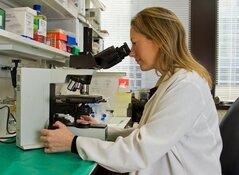The Life Sciences Report: What's the main differentiator for Biota Pharmaceuticals Inc. (BOTA:NASDAQ)?
Joe Patti: Biota Pharmaceuticals is focused on infectious diseases. Our core competency is in antivirals. We have three major programs targeting different viruses, using a combination of oral and inhaled drug delivery systems.
TLSR: What does Biota Pharmaceuticals bring to the antiviral therapy space?
JP: We're going after validated targets that we've seen in the scientific literature. If you have a safe, potent, small molecule that demonstrates good bioavailability at the relevant tissues, you should be able to generate a decent clinical outcome. Thus, for our human rhinovirus (HRV) programs, we're targeting the capsid with vapendavir. Vapendavir binds tightly in the VP1 capsid protein canyon, disrupting the ability of the capsid to bind to a specific cell surface receptor and inhibiting the successful release of the viral RNA into the cell cytoplasm during the viral uncoating process.
Also, there are several incidences in the literature in which potent drugs have yielded beneficial clinical outcomes for respiratory syncytial virus (RSV). For that program, we're targeting the fusion protein (F-protein). That's a well-known target, most notably addressed by MedImmune Inc. (an AstraZeneca Plc [AZN:NYSE] company) with Synagis (palivizumab). Although the drug was prescribed as a preventative measure rather than a therapeutic, it clearly showed the clinical value of targeting the F-protein.
For our influenza drug we're targeting the neuraminidase. Two neuraminidase inhibitors were approved in the late 1990s, notably Tamiflu (oseltamivir phosphate) and Relenza (zanamivir). Our LANI (laninamivir octanoate) neuraminidase program is a "one and done" treatment for influenza.
"We have a fairly mature, focused, clinical development pipeline focused on antivirals."
We feel good about the targets we've chosen, so our challenge is to develop the therapies appropriately for the clinic, to ensure safety and efficacy. Their clinical development paths are somewhat different.
For example, our vapendavir program treats upper respiratory infections caused by HRV in moderate to severe asthmatics. We anticipate that it will confer a benefit as these patients manage their asthma. Typically, asthma drugs are given daily to prevent exacerbations. What we're doing, however, is targeting the infectious disease trigger that can cause a loss of asthma control, a condition that can also trigger an exacerbation. That's a novel approach.
TLSR: How would you classify the company's stage of development?
JP: We're mid to late stage in the clinic, with two Phase 2 programs and one program between Phase 2 and Phase 3. Our earliest-stage program will enter the clinic this quarter.
TLSR: Let's talk about some of Biota's therapies in more detail, focusing on what's particularly innovative about each of them. Should we start with LANI?
JP: Laninamivir octanoate was approved in 2010 in Japan. It is inhaled. The novel approach is the one-time treatment regimen, unlike Relenza or Tamiflu, which are taken twice daily for five days. LANI has proven its efficacy in head-to-head trials in Japan, showing it was non-inferior to Tamiflu even though it was inhaled only once. It also has a very good resistance profile. This is particularly important for years in which the virus that emerges has a unique resistance profile, as it did in 2009.
The next program, BTA074 (formerly AP611074), was renamed after we acquired Anaconda Pharma in June. BTA074 is a topical, direct-acting antiviral. There are no such compounds or products on the market today for the treatment of human papillomavirus (HPV), which causes genital warts. The current state of the art for topical treatments is to enhance the overall local immunity to deal with the virus indirectly with an immunomodulatory compound.
"We have a very experienced team that has delivered value for shareholders in the past. We're hoping to do that again."
BTA074 is the first approach that deals directly with HPV. We're hopeful it will provide better efficacy, because it deals with proteins involved in the virus' replication. That's quite unique. And, it's delivered topically, which is what you would want to treat genital warts.
One of the major disadvantages of current topical therapies is their unfavorable local skin tolerability. The issue is so great that most patients can't even complete a complete course of therapy. They end up with erosions, ulceration and edema at the site of application, and stop applying the lotion, cream or gel because the skin is so raw.
From our early studies, however, the local skin tolerability of our product looks exceptional. The goal for our next clinical trial is to show that we offer better tolerability as well as better efficacy.
Vapendavir is our capsid inhibitor. It's oral, so patients take a pill twice a day for seven days. It targets human rhinovirus, the cause of the common cold. For most of us, a cold is discomforting but is insignificant. But for patients with moderate to severe asthma who are taking fairly high doses of inhaled corticosteroids, developing a cold can lead to an exacerbation of asthma symptoms and may cause them to increase their asthma medication. They may need to take oral steroids and, in very severe cases, they can be hospitalized because their lung function has decreased substantially.
"Next year's big data events will provide Biota with a lot of flexibility to make some very strategic decisions."
If asthmatics take vapendavir early in the development of an upper respiratory infection, it can stop the virus from growing in the lungs. Halting the infection should help these patients better maintain their asthma control and avoid the possible deleterious events associated with the respiratory infection.
Another program, BTA-C585, treats RSV. This is another oral compound. We anticipate beginning a Phase 1 study this quarter. This program is exciting because it addresses a very significant unmet need not only in pediatrics, but also in the elderly, as well as for immunocompromised patients. We will be generating data through the fall.
TLSR: Can you describe the upcoming BTA-C585 trial?
JP: The Phase 1 study will be conducted in the U.S. It will be a single ascending dose study (SAD) in healthy volunteers. We study the compound's safety and pharmacokinetics, and then progress to multiple ascending dose studies in which healthy volunteers receive escalating doses—in this case, for seven days. By starting low and escalating the dose, we can determine an appropriate dose level that we believe would be effective in treating the RSV infection.
TLSR: Tell me about Relenza (zanamivir) and its royalty outlook.
JP: Relenza is a legacy program. Biota Holdings—the Australian precursor firm to Biota Pharmaceuticals—did a collaboration license agreement with GlaxoSmithKline (GSK:NYSE) in 1990 that subsequently led to the development of Relenza. Biota Pharmaceuticals gets royalties on GlaxoSmithKline's sales of Relenza.
That program gained regulatory approval in 1998, so a lot of the intellectual property (IP) protecting that program is coming off-patent. We anticipate those royalties, which have been fairly substantial over the years, will continue to decline as the patents expire.
TLSR: Are you doing anything to rework Relenza (zanamivir) to extend the patent?
JP: No.
TLSR: But you've filed a request for a rehearing in a pending patent related to Relenza. Can you tell me a little more about that?
JP: It's interesting. This goes back to a 1994 patent application that was filed specific to the method of treatment by inhalation of Relenza. That patent was issued—and has since expired—in every country where an application was filed, except the U.S. In the United States, for whatever reason, we've never been able to get claims allowed for that application.
The issue stems from the patent office examiners' view of the claims as "obvious." We've tried for years, through expert witnesses, to make the counterargument—that in 1994 it wasn't obvious that an inhaled neuraminidase inhibitor would be effective for the treatment of influenza.
"We have extensive patent coverage on composition of matter, method of use and method of manufacturing for all of our clinical programs."
That's gone back and forth. We most recently filed an appeal because the previous brief was denied. Now we're waiting to see what the patent office comes back with. If we're denied again, we still have a few legal avenues to pursue. We'll work with GlaxoSmithKline to determine whether we pursue them.
If we were to allow that application to be abandoned, and did nothing more to get the claims allowed, we would no longer receive royalties in the U.S. for Relenza.
The major remaining IP for Relenza is in Japan. That will continue until July 2019. The good news is that Japan typically is the biggest market for Relenza. Therefore, we'll still maintain a decent royalty out of Japan.
TLSR: Are there other pending patents, global patents or licensing strategies we should talk about?
JP: Since we're talking royalties, you should know we get a royalty from sales of laninamivir octanoate, called Inavir, in Japan. It's sold by Daiichi Sankyo Co. (DSKYL:OTCPK). Those royalties in Japan will continue through 2024.
TLSR: What can you tell me about the rest of Biota's IP portfolio?
JP: For our other programs, we have extensive patent coverage on composition of matter, method of use and method of manufacturing for all of our current clinical programs. The timing and the breadth of those varies from program to program, but we have a fairly robust IP portfolio protecting our current programs.
TLSR: What can you tell us about the market potential for Biota's drugs, given the competition from major players with direct-acting antivirals that might be commercialized by 2020?
JP: We've just completed a fairly extensive marketing assessment for vapendavir, with the help of the IMS Consulting Group. We took a pretty conservative approach to determining the number of potential patients, penetration, competition and pricing, and we are very pleased with the predictions for the areas we're pursuing—adult moderate to severe asthmatics and pediatric asthma patients, and patients with chronic obstructive pulmonary disease (COPD).
We think the portion of the market we could capture is around $1.4–1.6 billion ($1.4–1.6B) a number of years after launch. The actual sales potential is larger, with a very substantial market opportunity for those indications.
TLSR: What about Biota's other programs?
JP: The market opportunity for RSV is a little hard to quantify because there are a significant number of patient segments we can target. One of the largest is pediatrics, but the elderly and the immunocompromised also comprise substantial markets. The magnitude of potential patients is clearly in the millions, but we haven't done sufficient work to put a sales number on these markets. That said, conservatively, I think they constitute a market opportunity worth $750 million ($750M) to $1B.
For the HPV program, based on what we've seen in the past, I think the U.S. alone probably would be a $300–500M opportunity. When the EU, Japan and other developed markets are added in, we believe that market opportunity could be around $800M. The current topical treatments are actually quite expensive, ranging anywhere from $300–1,000 per treatment, so you quickly see how that market could escalate.
TLSR: What is unique about Biota that investors should be aware of?
JP: I think what's unique is that we have a fairly mature, focused, clinical development pipeline focused on antivirals and, more specifically, respiratory antivirals. We will have some very important data read out next year.
"Our team is driving several exciting programs that address viral infections that currently have limited therapeutic options and represent sizeable global market opportunities."
That would be of real interest not only to investors, but also to potential partners or acquirers. Companies that have existing respiratory franchises around the development of medications for asthma or COPD, but that may not dealing with some of the root causes of the exacerbations caused by viruses, may be particularly interested. I think there would be great opportunity for partnerships to develop our antiviral programs alongside existing asthma medications to provide a broad-based approach to treating patients.
TLSR: How do you plan to move the company forward, to take it to the next step?
JP: Right now we're focused on execution. We have our Phase 2 study ongoing for vapendavir. We are planning to start another Phase 2 study later this year for the HPV program and, as I mentioned, this quarter we'll be starting a Phase 1 study for RSV. During the next 12–18 months we shall be moving forward by focusing on execution, on getting those trials up and running, on getting the data. A successful data set would set the stage for critical flexibility for the organization, helping us determine whether we partner for Phase 3 development, keep development in-house through Phase 3, or whether we could be acquired. Next year's big data events will provide Biota with a lot of flexibility to make some very strategic decisions.
TLSR: What do you, as CEO, bring to the company?
JP: For the past 11 years, I have worked as a senior executive in publicly traded biotech companies. Previously, I was the cofounder and chief scientific officer of an infectious disease company called Inhibitex Inc., which was involved in the development of antibodies, vaccines and antivirals. It was acquired by Bristol-Myers Squibb Co. (BMY:NYSE) in 2012 for $2.5B. I joined Biota Pharmaceuticals following the merger of Biota Holdings and the NASDAQ-listed company Nabi Biopharmaceuticals. Given my tenure as a senior executive at Inhibitex working in business development and investment relations, with scientific oversight of all our programs, I joined Biota as the executive vice president of corporate development and strategy. This past fall I was named President and CEO of Biota Pharmaceuticals Inc.
I've been through the trenches, seeing the good and the bad of small- to mid-size biotech. I think I bring some good perspective, so the lows aren't too low and the highs aren't too high, as we guide the company's multiple pipeline projects through clinical development.
TLSR: How does your experience as a cofounder of Inhibitex Inc., and the involvement of what looks like much of that company's management team, help you guide Biota Pharmaceuticals to its milestones?
JP: We do have quite a few ex-Inhibitex employees. I think that's because we've worked together well as a group in clinical, regulatory, preclinical and finance areas. We understand and complement each other's strengths and weaknesses. We have a very experienced team that has delivered value for shareholders in the past. We're hoping to do that again.
Biota today is a much different organization than it was two years ago. We are focused clinically now and, as our programs move forward, we believe we'll deliver shareholder value. In contrast, historically, Biota was research-focused. That's a significant change, so we obviously had to bring in the people with the appropriate skill sets. I, myself, am one example.
"We're very focused on delivering shareholder value."
The former Inhibitex staff has weathered a lot of ups and downs, going as far as a pivotal Phase 3 trial that, unfortunately, wasn't successful. That necessitated retooling that company, bringing in new assets and building it back up for a successful exit. That took a lot of work and a lot of emotional capacity. Bringing that experience to Biota will help us.
Where we're trading currently, from a market cap perspective, is in no way reflective of our assets. We have a good cash position and a low burn rate. We're on the verge of getting some very interesting data in the near term. We'll weather the low market cap. As you know, when positive data emerges, that can change the look and feel of a company very dramatically.
TLSR: You experienced a revenue decline in the third-quarter of 2015. Why?
JP: At one point, we had a contract with the Biomedical Advanced Research and Development Authority (BARDA), to develop LANI outside of Japan. As part of that program, all of our activities were reimbursed, plus a small profit margin. When that program was active, that income was recorded as revenue from services. When the contract was cancelled last May, the activities around that dwindled, thus reducing revenues.
TLSR: Your Q3/15 report also mentioned a restructuring. Would you care to elaborate?
JP: As part of this reorganization and focus on clinical development, we closed our Melbourne facility. We now have about 21 people in Atlanta, GA.
TLSR: What message would you like to give to potential investors?
JP: We're a mid- to late-stage clinical development company. We have a very good, somewhat derisked pipeline, and data from several Phase 2 studies emerging over the next 12–18 months that should drive considerable value. We're responsible in the way we manage our cash and have two royalty streams that continue to help offset our cash burn. We're very focused on delivering shareholder value.
At the end of last quarter (3/31/15), we reported $74.4M cash on hand, which I think is more than enough at this point to deliver the meaningful clinical data sets that we've been talking about. So that's a very solid foundation for growth, without the need for significant dilution in the near term.
TLSR: What three key points about Biota would you like investors to remember?
JP: The top three points, I would say, are the significant clinical data events within the next 12–18 months, our excellent cash position, and our experienced, clinically focused management team. That team is driving several exciting programs that address viral infections that currently have limited therapeutic options and represent sizeable global market opportunities.
TLSR: Thank you for taking time out to talk with us.
Dr. Joseph M. Patti was appointed chief executive officer and president of Biota Pharmaceuticals in October 2014. Dr. Patti joined the company in November 2012 and served as its executive vice president of corporate development and strategy. Prior to joining the company, Dr. Patti cofounded Inhibitex Inc. in 1998, and served as its chief scientific officer and senior vice president of research and development from 2007 until it was acquired by Bristol-Myers Squibb in February 2012. Before cofounding Inhibitex in 1998, Dr. Patti was an assistant professor at Texas A&M's Institute of Biosciences and Technology, and also served on the faculty at the University of Texas Health Science Center Graduate School of Biomedical Sciences. Dr. Patti is currently a director of SciStem Therapeutics Inc., a privately held company focused on developing cellular therapies for bone healing and musculoskeletal indications in both human and animal health. Dr. Patti was a director of Inhibitex from 1998 to 2005. Dr. Patti received a bachelor's degree in microbiology from the University of Pittsburgh, an M.S.P.H. from the University of Miami, School of Medicine, and a Ph.D. in biochemistry from the University of Alabama at Birmingham.
Read what other experts are saying about:
Want to read more Life Sciences Report interviews like this? Sign up for our free e-newsletter, and you'll learn when new articles have been published. To see recent interviews with industry analysts and commentators, visit our Streetwise Interviews page.
DISCLOSURE:
1) Gail Dutton conducted this interview for Streetwise Reports LLC, publisher of The Gold Report, The Energy Report and The Life Sciences Report, and provides services to Streetwise Reports as an independent contractor. She owns, or her family owns, shares of the company mentioned in this interview: None.
2) Biota Pharmaceuticals Inc. paid Streetwise Reports to conduct, produce and distribute the interview.
3) Dr. Joseph M. Patti had final approval of the content and is wholly responsible for the validity of the statements. Opinions expressed are the opinions of Dr. Joseph Patti and not of Streetwise Reports or its officers.
4) The interview does not constitute investment advice. Each reader is encouraged to consult with his or her individual financial professional and any action a reader takes as a result of information presented here is his or her own responsibility. By opening this page, each reader accepts and agrees to Streetwise Reports' terms of use and full legal disclaimer.
5) From time to time, Streetwise Reports LLC and its directors, officers, employees or members of their families, as well as persons interviewed for articles and interviews on the site, may have a long or short position in securities mentioned. Directors, officers, employees or members of their families are prohibited from making purchases and/or sales of those securities in the open market or otherwise during the up-to-four-week interval from the time of the interview until after it publishes.





































